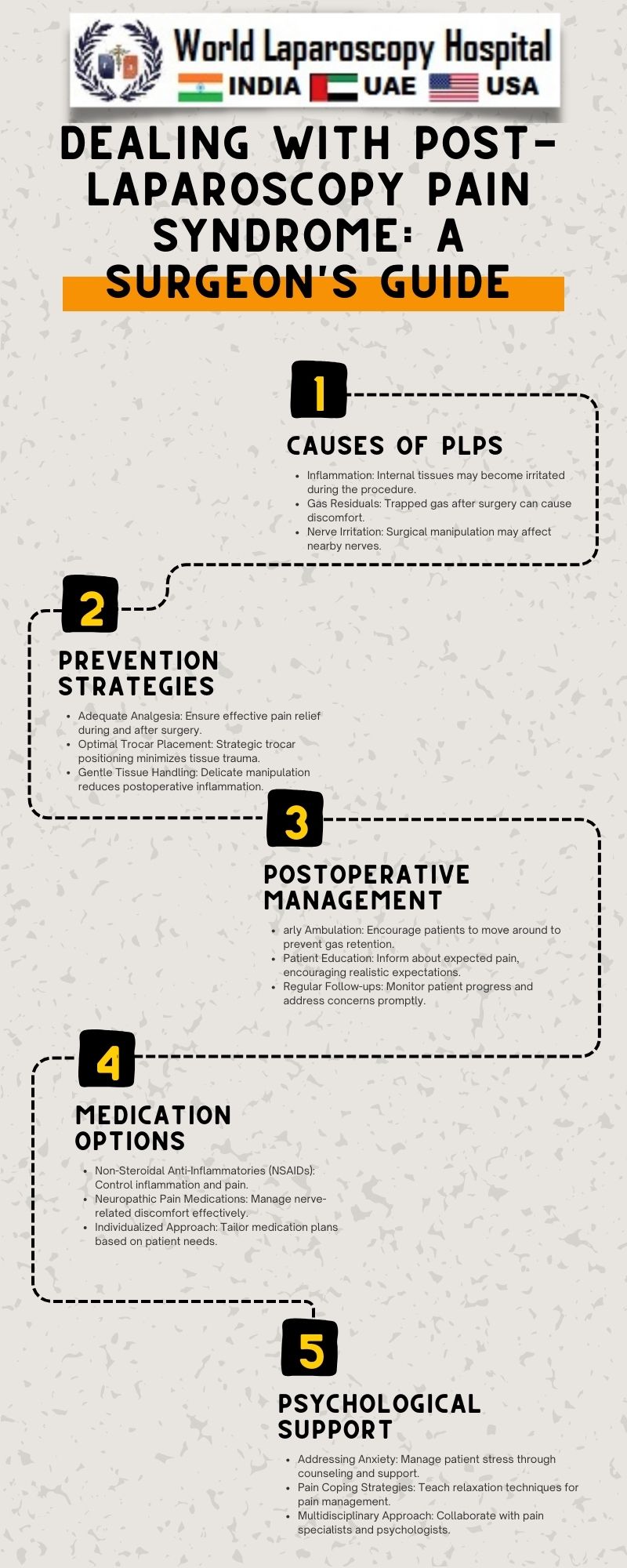Dealing with Post-Laparoscopy Pain Syndrome: A Surgeon's Guide
Dealing with Post-Laparoscopy Pain Syndrome: A Surgeon's Guide
Introduction:
Laparoscopy, a minimally invasive surgical technique, has revolutionized the field of surgery, offering reduced recovery times, smaller incisions, and overall improved patient outcomes. However, like any medical procedure, laparoscopy comes with its own set of challenges. One such complication that can arise is Post-Laparoscopy Pain Syndrome (PLPS). In this comprehensive guide, we will explore the nuances of PLPS and provide insights from the surgeon's perspective on how to effectively manage and alleviate postoperative pain.

Understanding Post-Laparoscopy Pain Syndrome:
Defining PLPS:
Post-Laparoscopy Pain Syndrome refers to persistent abdominal pain that persists beyond the expected recovery period following laparoscopic surgery. While laparoscopy is generally associated with less postoperative pain compared to traditional open surgery, PLPS can still occur and significantly impact the patient's quality of life.
Incidence and Risk Factors:
PLPS is not uncommon, with reported incidence rates varying between 0.5% to 6%. Several factors contribute to the development of PLPS, including patient characteristics, surgical technique, and the nature of the underlying pathology. Understanding these risk factors is crucial for both preventing and managing PLPS effectively.
Preventing PLPS:
Patient Selection:
A crucial step in preventing PLPS is meticulous patient selection. Surgeons must assess the patient's overall health, pain tolerance, and psychological factors before opting for laparoscopic surgery. Identifying high-risk individuals allows for tailored preoperative counseling and pain management strategies.
Surgical Technique:
The surgeon's approach during laparoscopy plays a pivotal role in minimizing postoperative pain. Techniques such as careful tissue handling, precise instrument manipulation, and strategic port placement can contribute to reduced tissue trauma and, consequently, decreased pain postoperatively.
Managing PLPS:
Early Recognition:
Prompt identification of PLPS symptoms is essential for effective management. Surgeons should educate patients about the expected postoperative pain trajectory and encourage open communication to detect any deviation from the norm early on.
Multimodal Analgesia:
Employing a multimodal analgesic approach is paramount in managing PLPS. Combining various analgesic agents, including non-steroidal anti-inflammatory drugs (NSAIDs), opioids, and local anesthetics, can provide more comprehensive pain relief while minimizing the risk of adverse effects.
Physical Therapy:
Integrating physical therapy into postoperative care can alleviate PLPS by promoting early mobilization, improving muscle strength, and addressing any postural abnormalities. Tailored exercises can aid in reducing pain and enhancing overall recovery.
Psychological Support:
PLPS is not only a physical challenge but also has psychological implications. Providing psychological support, such as counseling or referral to pain management specialists, can significantly contribute to the patient's overall well-being.
Reassessing the Surgical Approach:
In cases where PLPS persists, reassessing the initial surgical approach may be necessary. This involves a collaborative effort between surgeons and multidisciplinary teams to explore alternative techniques or interventions that may offer better pain control.
Future Directions in PLPS Research:
Understanding the Pathophysiology:
Further research is needed to elucidate the underlying mechanisms of PLPS. Investigating the neurobiological and inflammatory pathways involved in persistent pain post-laparoscopy can pave the way for targeted interventions and preventive strategies.
Innovations in Surgical Technology:
Advancements in surgical technology may influence the incidence of PLPS. Continuous refinement of laparoscopic instruments and techniques, as well as the exploration of robotic-assisted surgery, may contribute to further minimizing postoperative pain.
Conclusion:
Post-Laparoscopy Pain Syndrome is a multifaceted challenge that demands a comprehensive and collaborative approach. Surgeons play a pivotal role in preventing, identifying, and managing PLPS by incorporating a combination of meticulous surgical techniques, effective pain management strategies, and a patient-centered care approach. As we continue to advance in the field of surgery, a deeper understanding of PLPS and ongoing research will further refine our ability to enhance patient outcomes and minimize the impact of postoperative pain.
1 COMMENTS
Dr. Vijay Vashisth
#1
Jan 27th, 2024 10:03 am
Post-Laparoscopy Pain Syndrome is a complex challenge requiring a comprehensive approach. Surgeons play a pivotal role in prevention, identification, and management by employing meticulous techniques, effective pain strategies, and patient-centered care. Ongoing research will refine our ability to minimize postoperative pain impact and enhance patient outcomes.
| Older Post | Home | Newer Post |





